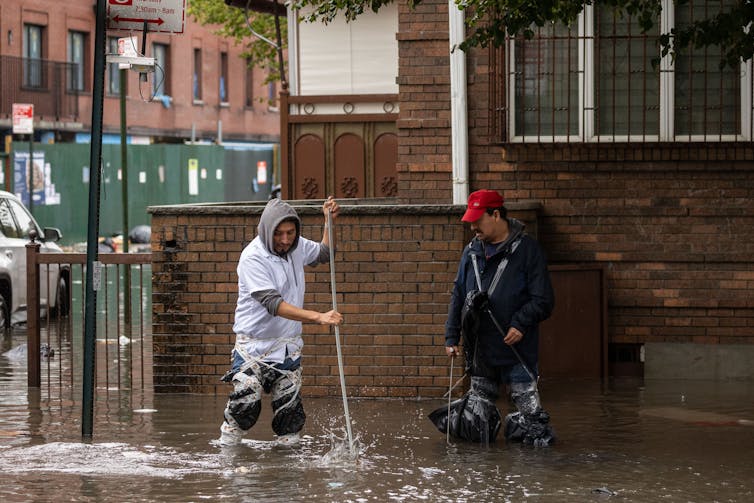
Elizabeth Mack, Michigan State University; Edward Helderop, University of California, Riverside, and Tony Grubesic, University of California, Riverside
During the height of the COVID-19 pandemic, Detroit residents got a break from water shut-offs.
In March 2020, just after the coronavirus made hand-washing a matter of public health, the City of Detroit announced a plan that kept water services on for residents for US$25 a month, with the first payment covered by the state.
Although all Detroiters had access to water during the pandemic, they continued to be billed at the higher standard rates.
In early 2023, Detroit resumed water shut-offs for bill nonpayment. Approximately 60,000, or 27% of Detroit’s 220,000 residential customers, had past-due bills last summer, according to the Detroit Water and Sewerage Department. The average customer owes $700, but some owe as much as $10,000 due to years of unpaid bills.
Although a variety of factors contribute to large past-due balances, water services in Detroit are expensive for many households, and the costs are rising.
We are geographers and policy analysts with an interest in water affordability, and we’ve closely studied access to water in Detroit and around the country.
Ties to historic bankruptcy
Water delinquencies are entwined with the city’s troubled financial history.
Detroit filed for bankruptcy in 2013.
A decline in the manufacturing industry that began in the 1950s and racial tensions in the 1960s and 1970s resulted in a decline in the city’s population. Foreign competition and bad management in the 1980s further damaged the domestic auto industry. By the time of the 2008 financial crisis, Detroit experienced soaring vacancy and jobless rates.
The decline in population was particularly problematic for the Detroit Water and Sewerage Department. The organization had built out infrastructure to the suburbs with borrowed money. The reliance on debt, coupled with a shrinking population, resulted in a large number of customers with past-due balances.
At the time of the bankruptcy filing, the Detroit Water and Sewerage Department accounted for one-third of the city’s $18 billion debt. In 2014, the agency shut off water service to thousands of residents to recoup past-due bills.
These shut-offs – as many as 141,000 from 2014 to 2020 – predominantly impacted low-income, disadvantaged families.
Costs are up broadly
It is not a problem that is limited to Detroit. Water shut-offs are also common in U.S. cities like Baltimore, Philadelphia, and New Orleans.
In 2016 alone, nearly 1.4 million Americans living in more than 500,000 households experienced a water shut-off for nonpayment.
No running water can cause physical and mental health issues – and even accusations of child neglect.

No end in sight
Neither public nor privately owned utilities have found a way to control costs.
Public utilities, like the Detroit Water and Sewerage Department, are managed by local and state governments. A governmental board of directors typically sets public utility rates. They generally reflect the cost of service with negligible administrative fees.
Private or investor-owned utilities, meanwhile, are managed by investors or shareholders and can be run as for-profit enterprises. About 12% of people in the United States get their water from private utilities. This percentage varies, with private utilities more common in states such as Indiana, Ohio, and Idaho.
Customers served by private water utilities, on average, pay more for the same type of service as those served by public providers, even though there is no evidence that private utilities operate more efficiently than their public counterparts.
The bottom line is that both public and private utilities are charging more.
One reason is that federal government subsidies have dropped. In the late 1970s, the federal government paid nearly two-thirds of the total capital spending for water and sewage infrastructure, a figure that is down to under 10% today. These additional costs are passed directly or indirectly on to consumers.
Aging infrastructure is also driving up costs.
A huge system in poor shape
The water and sewage systems in urban America are old.
In all, 2.2 million miles (about 3.5 million kilometers) of pipe make up the U.S. water and sewer system, with many of those pipes well beyond their expected end of life. Due to the time and expense of replacing individual pipe segments in active water systems, particularly in dense urban areas, many municipalities make repairs or replacements only when a problem like a water main break occurs.
Neglected water systems result in billions of gallons of water lost to leaks every day, while the aging infrastructure was never engineered to support the large populations that now reside in U.S. cities.
In addition, climate change is further straining the systems, as wastewater treatment facilities struggle to treat excess stormwater, while saltwater intrusion into coastal aquifers decreases water availability and increases the rate of pipe corrosion.
Solutions to the problem
Municipalities have tried several solutions to help households cope with unaffordable water bills.
Customer assistance programs take many different forms, ranging from bill discounts and payment plans to the forgiveness of past-due amounts.
Individual utilities decide whether to offer these programs.
In Detroit, the water utility launched a payment plan in August 2022 that erases past-due amounts for those who are eligible to enroll. Eligibility is based on income with charges as low as $18 a month. Customers who earn up to 200% of the federal poverty level can take part. However, the program doesn’t have a long-term source of funding. Detroiters who earn more than 200% of the federal poverty level are not eligible for debt forgiveness and are still subject to shut-offs – as are those who fail to pay their reduced bills.
In Philadelphia, the tiered assistance program creates individualized, affordable bills for customers enrolled in the program. Under this program, prior penalty charges from past-due amounts are forgiven for customers enrolled in the program who make payments in full for 24 months. The Philadelphia City Council passed a special bill to make the program possible, so there may be legislative barriers to offering this type of solution in other cities.
If you live in another American city and feel as if your water costs have gone up, you’re probably not wrong. American water costs are rising steadily, up 31% on average since 2012.
More accessible data about water costs, how many customers owe money and how much, and the number of shut-offs would help utilities to benchmark performance. It would also help consumers and policymakers understand trends in water and wastewater rates.
Elizabeth Mack, Professor of Geography, Michigan State University; Edward Helderop, Associate Director of the Center for Geospatial Sciences, University of California, Riverside, and Tony Grubesic, Professor of Public Policy, University of California, Riverside
This article is republished from The Conversation under a Creative Commons license. Read the original article.




